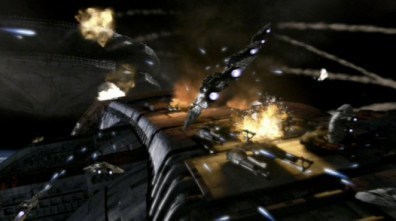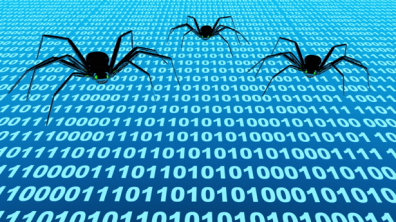Matthew S. Williams's Blog, page 149
January 19, 2013
China’s Drones Trigger Fears of Drone Race
 Twice a year, China showcases the latest in military technology at a show held in Zhuhai city, in the Guangdong province. During the last show, held in November, a series of new unmanned aerial vehicle,s most of which bore a striking resemblance to the American drones that have been conducting attacks in Afghanistan and Pakistan for the past few years. Naturally, observers in the west were rather concerned with the wider implications.
Twice a year, China showcases the latest in military technology at a show held in Zhuhai city, in the Guangdong province. During the last show, held in November, a series of new unmanned aerial vehicle,s most of which bore a striking resemblance to the American drones that have been conducting attacks in Afghanistan and Pakistan for the past few years. Naturally, observers in the west were rather concerned with the wider implications.
Until recent years, the United States, Britain and Israel have maintained supremacy in the field of UAV’s. But much like stealth technology and naval aviation, the Red Dragon appears to be catching up by leaps and bounds. What’s more, it is likely China intends to take full advantage of using unmanned aerial vehicles to achieve its national interests, which includes their territorial disputes with Taiwan over the Senkaku Islands and South China Sea and Japan.
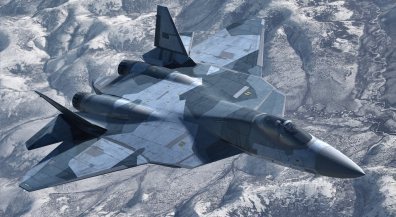 In response, the Defense Science Board released an unclassified report in they claimed: “In a worrisome trend, China has ramped up research in recent years faster than any other country. It displayed its first unmanned system model at the Zhuhai air show five years ago, and now every major manufacturer for the Chinese military has a research center devoted to unmanned systems.”
In response, the Defense Science Board released an unclassified report in they claimed: “In a worrisome trend, China has ramped up research in recent years faster than any other country. It displayed its first unmanned system model at the Zhuhai air show five years ago, and now every major manufacturer for the Chinese military has a research center devoted to unmanned systems.”
The report went on to say that “the military significance of China’s move into unmanned systems is alarming [suggested that China could] easily match or outpace U.S. spending on unmanned systems, rapidly close the technology gaps and become a formidable global competitor in unmanned systems.”
 Two Chinese models on display at the Zhuhai show — the CH-4 and the Wing Loong, or Pterodactyl — appeared to be clones of the Reaper and Predator drones that are fixtures in the U.S. arsenal. A larger drone, the Xianglong, or Soaring Dragon, is a long-range, high-altitude model that would seem to be a cousin of the RQ-4 Global Hawk.
Two Chinese models on display at the Zhuhai show — the CH-4 and the Wing Loong, or Pterodactyl — appeared to be clones of the Reaper and Predator drones that are fixtures in the U.S. arsenal. A larger drone, the Xianglong, or Soaring Dragon, is a long-range, high-altitude model that would seem to be a cousin of the RQ-4 Global Hawk.
Huang Wei, the director of the CH-4 program at the China Aerospace Science and Technology Corporation, told the state-run newspaper Global Times that his lightweight drone can carry cameras, ground-searching radar, missiles and smart bombs. “As the Americans say,” he said, “the U.A.V. is fit for missions that are dirty, dangerous and dull.”
What will this mean for the future? Drone wars? Or a new arms race where increasingly complicated unmanned aerial vehicles and stealth fighters are involved? Difficult to say, but with the advances of such weapons systems in other countries, it was only a matter of time before China followed suit. One can only hope, as the saying goes “that cooler heads prevail” before they are used in an open conflict.
Source: policymic.com, nytimes.com


Wanted: People for Mars!
 They’re called Mars One, a nonprofit organization based in the Netherlands that intends to establish a human settlement on the Red Planet by 2023. What began as a proposed Reality TV project that would hopefully recoup the costs of sending people to Mars has since matured into a project for actual, factual colonization. There’s just one thing missing at this point…
They’re called Mars One, a nonprofit organization based in the Netherlands that intends to establish a human settlement on the Red Planet by 2023. What began as a proposed Reality TV project that would hopefully recoup the costs of sending people to Mars has since matured into a project for actual, factual colonization. There’s just one thing missing at this point…
They need people to volunteer.
A little over a week ago, they released a document specifying their application criteria. Clearly, they can’t take just anyone. Among the five key categories for qualification are Resiliency, Adaptability, Curiosity (no pun!), Ability to Trust, Creativity and Resourcefulness. Oh, and you must be at least 18 years of age, kind of like getting in to an R-rated movie. No specific technical qualifications are necessary, but if you’ve got a go-getter attitude, a positive outlook and are willing to learn, I’m sure they can teach you.
 The selection process will begin during the first half of 2013, and will still be based around a reality TV concept. Basically, it will take the form of Mars One experts and viewers of a “global, televised program” choosing who they want to see go. Those ultimately selected will be assembled into teams of four, with at least six teams hoped to be prepared to launch in September 2022. But only one team will make the first trip to the Red Planet, and that team will be decided democratically.
The selection process will begin during the first half of 2013, and will still be based around a reality TV concept. Basically, it will take the form of Mars One experts and viewers of a “global, televised program” choosing who they want to see go. Those ultimately selected will be assembled into teams of four, with at least six teams hoped to be prepared to launch in September 2022. But only one team will make the first trip to the Red Planet, and that team will be decided democratically.
The training process will take eight years, and will include simulated missions, practice in a restricted mobility environment, and lessons in electronics, equipment repair, basic and critical medical care. In 2016, the company plans to begin rocketing supplies to Mars, including spare parts, two rovers, and living units that can be assembled into a base once humans arrive.
It’s a testament to an age where commercial space flight is fast becoming a reality, and internet-based voting, crowdsourcing and information sharing can take the place of space agencies and government sanctioned research. Sure, it still sounds like a pipe dream, but the effort alone is impressive isn’t it? And given all the advances that are made every day, who’s to say what will and won’t be possible within the next few decades?
To read the application in detail, click here. And check out the video of Mars One’s proposed mission:
Source: wired.com, blastr.com


BSG: Blood & Chrome (Ep. 9-10)
 We come to it at last, the finale of the webseries BSG: Blood & Chrome! And much like with the rest of the show, my feelings were largely positive, with just a few rejoinders. There were some flaws, some weaknesses; mainly things that pointed to some writing and/or production issues. But overall, it was a testament to the enduring appeal of the relaunched franchise and its creative team.
We come to it at last, the finale of the webseries BSG: Blood & Chrome! And much like with the rest of the show, my feelings were largely positive, with just a few rejoinders. There were some flaws, some weaknesses; mainly things that pointed to some writing and/or production issues. But overall, it was a testament to the enduring appeal of the relaunched franchise and its creative team.
And I look forward to when the Syfy network will be airing it this month, as I imagine an official launch will correct a lot of these bumps. As I’m sure we can all agree, there’s nothing that can’t be fixed with bigger budgets and more oversight! But of course, I digress. Here’s what happened in the final two episodes and the culmination of the webseries.
Episodes 9-10: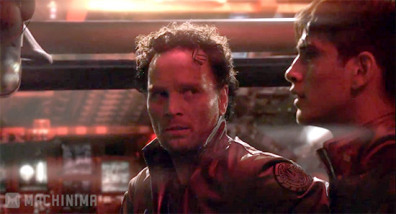 The series opens once again with our heroes being held up inside the resort on Djerba after the Cylon attack. Toth is dead, and once again, an argument erupts over what they are to do. Adama and Kelly insist they continue, but Coker raises his weapon at her and demands that she divulge the details of their mission first. She begins explaining that the target is an automated communications hub located on the planet, and her mission is to upload a virus contained in her dogtags.
The series opens once again with our heroes being held up inside the resort on Djerba after the Cylon attack. Toth is dead, and once again, an argument erupts over what they are to do. Adama and Kelly insist they continue, but Coker raises his weapon at her and demands that she divulge the details of their mission first. She begins explaining that the target is an automated communications hub located on the planet, and her mission is to upload a virus contained in her dogtags.
They proceed on foot to the communications hub and find it undefended. Kelly hops on the Cylon terminal and begins to upload the contents of her dogtags, but Coker shoots her when he sees a Battlestar on the display screen. He tells Adama that she is a traitor, and that the Cylons spared her back at the resort because they saw what she was carrying in her dogtags and realized she was one of them. Kelly shoots Coker and holds Adama at gun point, and explains that her betrayal is necessary since the Cylons are just defending themselves and value life more than humans do.
 Adama shoots Kelly and destroys the array. She leaves Kelly behind and drags Coker away from the array. Together, they wait outside in the snow for a rescue and Coker reveals that he has a wife waiting for him back at home. Coker then gives Adama the photo and apparently dies, and a Raptor arrives to pick them up. Back at the array, a semi-humanoid Cylon comes to Kelly and tells her that her “more enlightened” views do not excuse her from the Cylons hatred, and then snaps her neck.
Adama shoots Kelly and destroys the array. She leaves Kelly behind and drags Coker away from the array. Together, they wait outside in the snow for a rescue and Coker reveals that he has a wife waiting for him back at home. Coker then gives Adama the photo and apparently dies, and a Raptor arrives to pick them up. Back at the array, a semi-humanoid Cylon comes to Kelly and tells her that her “more enlightened” views do not excuse her from the Cylons hatred, and then snaps her neck.
Adama finds himself aboard the Galactica and is met by Commander Nash, who explains to him that they knew of Kelly’s planned betrayal and moved accordingly. While they were on Djerba and the Cylons were following Kelly’s transmission, the “ghost fleet” struck at a dozen Cylon installations and bases along the front. He gives Adama a pep talk about the need to sacrifice all things, even the facts, for the sake of the war effort, and Adama reluctantly accepts. He is transferred to a Viper squad and is reunited with Coker, who appears to be alive after all.
Adama joins the fleet and begins flying as a combat pilot. The war continues, with Colonial forces winning, and the series ends with Adama sealing a letter to his father.
Summary:
Like I said, there were some weaknesses in this final installment which I could not overlook. It still managed to deliver and ended on a high note, but the bumps along the way need to be acknowledged. First, there were some scripting errors which were pretty similar to stuff found in previous episodes and evidence of cut corners. This could be written off as due to budgets and the need for quick production, but what can you say? These things tend to stand out.
First off, there was the fact that Toth is written off and is not seen again after his quick death in episode 8. Much time was dedicated to the fact that this man was as a survivor who managed to stay alive in a hostile environment permeated by Cylons and their ugly creations. But as soon as the attack party shows up, he goes down mighty quick and is never heard from again. Feels weak.
And then, in the course of yet another argument of what they are to do, Coker and Kelly discuss the true nature of their mission, and it sounds like a broken record on repeat. Basically, she tells him that their target is an automated communications array not once, not twice, but thrice! All the while, he keeps demanding she tell him everything, but she just says the same thing each time: “The target is an automated facility. The automated facility is six km from here. It’s automated so it’s undefended.” That’s basically what she says. Did the writer forget to proofread or something?
And they also confirm in these last episodes that the resort was a place where the Cylons were carrying out experiments on human anatomy that were clearly part of their ongoing efforts to merge the organic with the synthetic. So… why was Toth based there? If this was a Cylon facility, why was the lone survivor of the special ops team hiding out there and using it as his personal base? Wouldn’t that be considered bad tactics, since it was a guaranteed way of getting the Cylons to come find you?
And then came the scene where Kelly is confronted by the quasi-humanoid Cylon that is meant to call to mind Caprica Six and the other flesh and blood Cylons from the new series. It is still in production and only has flesh along one arm, the rest composed of an anthropomorphized shell and with a female voice. After finding her wounded, this sympathizer who tried to help them, it simply tells her that “we don’t hate you any less just because you side with us”, and then proceeds to snap her neck.
Seriously, that was kind of dumb. This is a woman with operational intel of the Colonial Fleet who helped to design them. Why would they kill her, except out of some sense of blind, irrational hatred designed to prove that the Cylons really and truly were evil? That was my feeling in this scene, that it was set up to disprove everything she said about how the Cylons value life more than humans. And I couldn’t help but feel that a much better plot point would be to have them take Kelly’s and use her to further their experiments with creating biological machinery.
But of course, there were good parts as well and plenty of saving graces. For example, I was kind of wondering what happened to the rest of the ghost fleet after the Osiris jumped in to Djerba to do their attack run. Turns out, it was earmarked for a big offensive in other sectors. Made sense, and also provided some simple but effective resolution to the story and explained how the war effort got turned around. What’s more, the ending provided some hints that a continuation would be in the works, a series that follows how the Colonial Fleet went from fighting a losing war to beating the Cylons and sending them into exile.
And sure enough, the special effects, tone and tempo of the show never failed to impress. In the end, as with the rest of the series, you get the unmistakable sign of quality and attention to detail which anyone who loved the relaunched series or Caprica would come to expect. Yeah, at times you get that artificial environment or “that doesn’t look real” feeling, but sure as shit, the CGI has come a long way in the past few years and its shows here.
Well that about wraps up the BSG: Blood & Chrome series. As I said, it is expected to air as a televised movie this month on the Syfy network, and based on the popularity of that, could turn into the next BSG miniseries. Fingers crossed, because I think there’s plenty of potential to be had here! Not only are William Adama and Coker, as portrayed by Luke Pasqualino and Ben Cotton good characters, but I personally felt that Brian Markinson (who played Commander Nash) didn’t get enough screen time and would be an awesome character.
And of course, there’s plenty of story arc to be had. In addition to all the action and warfare, you could also show how Adama and Tigh first met, how Adama worked his way up the chain of command to become an officer. How he and Tigh fell on hard times, and delve into the motivations of the Cylons and how they came to meet the Final Five and were given resurrection technology way back when. Ordinarily, I’m not a fan of prequels, but I tell ya, there’s plenty of material here! Exploit, people, exploit!

January 18, 2013
Real Life Superhero?
 His name is Phoenix Jones, and he’s the superhero keeping the streets of Seattle safe. Well, sort of. Back in November, the masked vigilante took down a loud-mouthed bigot in a street bawl, and the footage was caught on tape. However, it seems that he might be in the market for some help, and he’s calling on able-bodied, justice-minded citizens to join him.
His name is Phoenix Jones, and he’s the superhero keeping the streets of Seattle safe. Well, sort of. Back in November, the masked vigilante took down a loud-mouthed bigot in a street bawl, and the footage was caught on tape. However, it seems that he might be in the market for some help, and he’s calling on able-bodied, justice-minded citizens to join him.
I should take this opportunity to mention that this is not a joke. Nor is it an opportunity to plug the recurring Revenger segment we host on this site (but no one would fault you if you wanted to take this opportunity to go check it out!). In fact, the state of Washington allows for two men to settle disputes by fighting in the streets so long as there is mutual consent. So vigilante justice is not a farfetched concept.
But of course, Phoenix Jones would like to state that it takes more than that to be part of his “Justice League”. Specifically, he’s looking for people who are at least 18 years of age, are residents of Washington, have a clean criminal record (of felony or violent crimes), have some sort of fighting or martial arts experience, first aid/CPR cards, and a level 2A or above bulletproof vest. Oh, and you can’t be a journalist looking to uncover his secret identity. Sorry Lois!
And just in case you’re having second thoughts, here is Jones’ promotional video. If you’re interested, just follow the Jones’ signal to its source, and don’t be too surprised to see the man in the molded suit of grey and yellow rubber.


The Future is Here: Smart Tattoos!
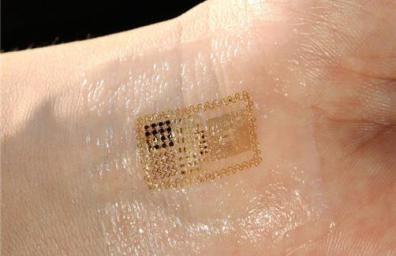 In recent years, scientists have been working towards electronics that come in flexible and ultra-thin packages. Back in 2011, this bore fruit as researchers from the University of Illinois unveiled the world’s first health monitoring patch, an ultra-thin device which looked like a temporary tattoo, but packed enough sensors in its flesh to monitor a person’s vitals. As a testament to the rate at which technological developments happen these days, improvements are already being made on the concept and design.
In recent years, scientists have been working towards electronics that come in flexible and ultra-thin packages. Back in 2011, this bore fruit as researchers from the University of Illinois unveiled the world’s first health monitoring patch, an ultra-thin device which looked like a temporary tattoo, but packed enough sensors in its flesh to monitor a person’s vitals. As a testament to the rate at which technological developments happen these days, improvements are already being made on the concept and design.
For example, a team of researchers from the University of Toronto and the University of California recently announced the creation of what they are calling the “smart tattoo”. This device is a step up from the previous one, as it contains “ion-selective electrodes” which go beyond monitoring just your vitals. According to the collaborative team, this patch is made up of “sensors that detect the pH or salt levels of the skin, as well minerals like potassium, and even blood oxidation.”
In other words, this patch can monitor athletic performance at a granular level, but without any of the bulk or wiring of older sensors. It also means that for the first time, detailed athletic response testing would no longer be limited to the walls of a sports clinic, but could be done daily by the athlete herself. What’s more, the nature of the design and relative cost are in keeping with a mass production model and mass market appeal.
 This last aspect is an important indicator since one of the hallmarks of technological progress is the ability to create devices which go beyond matters of life and death and are able to address our daily concerns. In addition to proving that the technology is becoming more commonplace, it’s also a sign of growing affordability and availability. With this latest development, it seems that smart tattoos are doing just that.
This last aspect is an important indicator since one of the hallmarks of technological progress is the ability to create devices which go beyond matters of life and death and are able to address our daily concerns. In addition to proving that the technology is becoming more commonplace, it’s also a sign of growing affordability and availability. With this latest development, it seems that smart tattoos are doing just that.
Another example comes from Sano intelligence, a 2012 health startup that announced that they are in the testing phase of a smart tattoo that reads a wearer’s blood markers. This patch would be especially useful to diabetics, for whom blood monitoring is a constant hassle and often required invasive measures, such as needles. If the patch proves successful, diabetics everywhere would not only be able to forgo finger pricking and needles, but would also be freed of the burden of having to carry around bulky devices.
 Finally, there was the news from Cambridge Massachusetts, where another startup company named MC10 announced early in 2012 that they had created a “stretchable electronics” patch that was applicable not only to skin, but to human clothing and even organs. By mounting nanoscale electronics to a flexible, stretchable patch, the company hopes to be able to produce sensors that can monitor any number of health functions, from the more mundane things like heart-rate and hydration, to brain, heart, tissue, and organ function.
Finally, there was the news from Cambridge Massachusetts, where another startup company named MC10 announced early in 2012 that they had created a “stretchable electronics” patch that was applicable not only to skin, but to human clothing and even organs. By mounting nanoscale electronics to a flexible, stretchable patch, the company hopes to be able to produce sensors that can monitor any number of health functions, from the more mundane things like heart-rate and hydration, to brain, heart, tissue, and organ function.
What is especially exciting about all of this is not so much the technology involved, but the fact that it is leading to an era where patients will have a far greater degree of control over their own health and monitoring. No longer will we be dependent on clinics and doctors for every single matter relating to our health, from checkups to surgery. Now we can take care of the former ourselves, making our information available to our doctor or specialist as needed, and going in for only serious or life-threatening procedures. This, in addition to leading to a more health-conscious public, could also bode well for medical costs.
Sources: takepart.com, technologreview.com, factcoexist.com


Pappa Zulu – Chapter 46
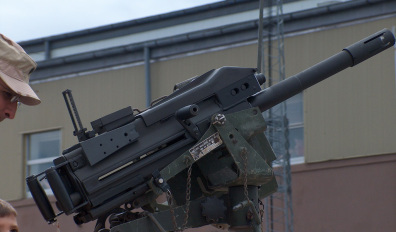 “It is even better to act quickly and err than to hesitate until the time of action is past.”
“It is even better to act quickly and err than to hesitate until the time of action is past.”
-Karl Von Clausewitz
They kept the lead chopper in their sights, hoping to catch some sign of the thing if and when it went up. At the same time, they monitored it for any sign of sudden movement. As they all knew, there was a good chance they would see Whitman and the fire team moving before they could take shot, and kill them horribly.
He looked down the street to the burning pyre where Viper One Three’s vehicle was sitting. It’s launcher as looking skyward, idle and unmanned. Third squad had already emerged from their cover behind another abandoned building, and were making their way towards it little by little. At the moment, the smoke and flames were keeping them concealed from the chopper pilots’ eyes and IR sensors, but the moment they got to the vehicle, that would change.
It was an unfortunate part of their plan that as the third element in this plan, all they could do was wait for things to happen. There wasn’t much they could do. If they tried to open up with their meager 203′s, they’d reveal the entire platoon and most likely die in the process. Still, waiting sucked ball…
Next to her, she could hear Braun muttering to himself. “C’mon… c’mon…”
In her head, she was doing the same. Too many of her squad had died today, and far too many members of their platoon. Nothing could go wrong here.
Whitman’s voice sounded over their comms and she nearly jumped. They were in position, said his report, the chopper in their sights.
“Weapon’s free,” ordered the LT. Saunders took a deep breath and waited for the fireworks. No matter how things went in the next few seconds, they could be sure it would be explosive.
She heard a loud click from behind her, then the sudden discharge of flame and compressed air. A loud shriek followed, and then a bright flash and a thunderclap. She looked away for a second, and then looked back to see a fiery object spinning in the air.
The rocket had landed, though slightly rear of the chopper’s main fuselage. The tail section was now a flaming wreck, the rotor and tail fin blown clean off. She caught a quick glimpse of the pilot and gunner struggling with their controls as they began to spin uncontrollably.
“Take cover!” Braun yelled.
The chopper spun out and landed in the middle of the street. Saunders and the others barely had to time to hit the ground, and she took Gorman down with her. He had been behind them and had been the last to react, and he got the side of her rifle in the face because of it. But aside from his wounded pride and some lacerations from some added peppering of glass, neither he nor they were wounded too bad.
Braun looked up and spotted her and Grayson next to him. Together, they could hear the sound of rattling and popping outside. Both the chopper and third squad were firing on each other, and there was no telling who was striking true.
“On your feet, soldiers! Third squad is engaged!”
Those who could obliged, followed shortly thereafter by those who were nursing wounds or winded from the blast. Saunders became momentarily unaware of exactly who that was, as the pounding of her boots and her heart deafened her to everything else. And the only thing in her visual field which registered at the moment was the sudden burst of light as she jumped out of the storefront and into the open.
That’s when everything slowed down. The light took her, the sights and sounds moving so slowly that it seemed like everything was happening underwater. She could hear the telltale wup wup wup of the rotors coming from above, followed quickly by the loud brack, brack of the Apache’s gun. She looked to her right and saw Third’s squad vehicle, the man on top hanging limply in place with his arms dangling at his sides. Several large holes surrounded him, his blood pooling in them and dripped down into the cabin.
She looked left, and did not see the chopper above. It’s rotors and gun were chewing up the air, but not at the intended target. And behind her, many bodies were moving up to join her.
Things began moving normally again when Braun began yelling to all assembled. He looked to Third’s Humvee and in the direction the noise was coming from and drew the proper conclusion.
“Shit! We were too slow! Fuckers doubled back and has our fire team lined up!”
Saunders looked in horror back into the store where Whitman and his comrades had been moments before. Their rocket had taken down the one chopper, but now they had the other one on top of them. She couldn’t see it from where they stood, but she heard it all the same. Through the door in the back, she saw debris flying as well.
“They’ll be cut up in that alley!” Braun yelled next. His hands became a blur as he ordered their platoon about. “Saunders, your with Grayson and Gorman. Second, move around that back end of the building and pull those men out!”
“Sir,” said Tate, “where are you going?”
“Round front. Gonna give him something else to shoot at!”
Tate looked hesitantly at Braun, but nodded and obeyed all the same. Grabbing his squad, he began to run around the south side of the building, hugging the wall. With them gone, he turned to Saunders and Grayson, anticipating what they would say.
“Move around the front end and distract that sonofabitch with your two-oh-threes. I’ll guide third into position to help cover you!”
He ran off behind them, waving his own arms at Third and the driver of the Humvee. Saunders kept watching him, longer she was supposed to given that Grayson had to get in her face.
“You heard the Lieutenant, Sergeant! Move your fucking ass!”
She threw up her SCAR and followed the other two as they rounded the building in search of the rotors. She looked back just one more time, to see Braun with his back still turned, his arms still waving and directing the Humvee. She became angry with herself, lingering to watch him when some of her own were trapped on the other side of the building. If they weren’t already dead, they soon would be if she didn’t get her ass in gear and get on that marauding chopper.
She slammed her boots into the concrete and pushed forward, almost barreling through Gorman and Grayson in the process. When they rounded the corner, they spotted the Apache, hovering low and loud in place just a few dozens meters above them. Its nose was pointed towards the alley behind the store, which put it almost exactly nose to nose with them.
“Hold!” yelled Grayson. Saunders and Gorman nearly fell over as they dug in their feet and skidded against the hard ground. The firing stopped, and the gun began to move…
Saunders didn’t hear what Grayson said next. Her hearing once again became selective as the sound of her weapon popping was all that registered. The airburst shell went off, clumsily aimed, but still pointed in the Apache’s general direction. Then a number of sounds blared out at once, all of them competing to overwhelm her.
There was the sound of renewed gunfire, a loud bang, and the sound of Grayson’s voice in her ear as he grabbed hold of her and pulled her backwards.
“Get down!” She was yanked by her collar and fell to the ground, landing next to Gorman. The wall erupted in a hail of shattered brick and mortar, and Grayson hollared as he dove in front of them and hit the ground so hard it knocked the wind out of him. He rolled over and his face was bloody, but he was still breathing. Saunders tried to get to him, but the explosions continued, sending her back to the relative protection of the wall.
“Stay back!” Grayson could be heard yelling as well.
She felt a shard of something solid solid hit her face and she drew her hands to her face. Amidst the noise, she couldn’t even hear herself screaming, let alone those of Gorman. But what glimpses she caught of him told her he was also freaking out, his mouth fully open and his hands covering his eyes.
All that was replaced by a loud screech and some more thundering. She looked up to see Thirds Humvee stopping suddenly in the middle of the road and opening up with its gun. From the perch, he had the sun right behind him, but she could make out the general outline of Lieutenant Braun, manning the gun and throwing off empty case shells. One by one, the shells burst from the stubby launcher and sailed past them into the air.
Several loud thumps, and a loud crash followed. Several moments seemed to pass, followed by the sounds of loud cheering…
She learned forward and looked around the edge of the building. In a large tree, sitting by the side of the highway, the wreckage loomed and burned brightly. A single burning man forced the window of the cockpit open and then fell to the ground, where several dust plumes were kicked up and brought spouts of red from his chest. He fell back lay still. She heard the advance of bootsteps…
“Take that, you chickenhawk motherfucker!”
The hooting and hollering resumed. She could hear a familiar voice, and smiled.
“Hoo-ah dickhead! Not so tough when you’re sucking dirt, are ya?”
She strained to see a little farther around the corner. There, grabbing his crotch and giving the downed chopper pilots the bird, was Whitman, alive and well. Majorca and Francesco were there too, though the latter looked a little worse for wear.
With that in mind, she looked back at Grayson and went to his side. His face was oozing blood, but the damage appeared to be superficial. She snapped her fingers in front of his face a few times to see if he was still conscious too. He winced to indicate he was.
“Sergeant, you alright?”
“Just fine,” he said gruffly. “Get to my feet, Saunders, ‘less you feel like changing my diaper.”
She chuckled and grabbed a hold of his hand, hoisting him up. She checked over her shoulder to make sure Gorman was still breathing too. Aside from also needing to be changed, he seemed fine, at least physically.
“Guess that’s two I owe you, Grayson,” she said dryly. “Please don’t make this a habit.”
Even through the rips in his face, she thought she could discern a smile, though it might have been a grimace. It was hard to tell at the moment.
“Just don’t make it a habit of getting in trouble,” he replied. “We’ve lost enough people as it is.”
She ceased smiling and looked past him. To the Humvee, to the gunner’s perch where the LT was still sitting. His eyes were fixed on the burning wreck in the distance and he seemed to be drawing several deep breaths. Beneath him, the driver and passenger waited anxiously, looking for either orders or permission to hop out and enjoy the moment. He wasn’t giving them either.
“Yeah,” she said finally. “But we’re still alive. That has to count for something.”


Drone Wars!
 That’s the crux of Timothy Chung’s research, an assistant professor in the Systems Engineering department at the Naval Postgraduate School in Monterey, California. For the most part, he and the Advanced Robotics Systems Engineering Lab (ARSENL) have been working on a way to construct a series of low-cost, lightweight autonomous flying vehicles known as Aerial Battle Bots that will give the US and the western allies an advantage should a full-scale conflict involving UAV’s happen.
That’s the crux of Timothy Chung’s research, an assistant professor in the Systems Engineering department at the Naval Postgraduate School in Monterey, California. For the most part, he and the Advanced Robotics Systems Engineering Lab (ARSENL) have been working on a way to construct a series of low-cost, lightweight autonomous flying vehicles known as Aerial Battle Bots that will give the US and the western allies an advantage should a full-scale conflict involving UAV’s happen.
The aspect of cost is especially important, seeing as how drones cost on the order of several million dollars apiece. By supplementing reconnaissance and hunter-killers with dogfighting drones, the army and navy of the future will have a lost cost-option for keeping their big-budget fliers safe. What’s more, it’s extremely important that the drones work in tandem, since it’s highly likely other nations will be developing similar swarms of drones in the future too.
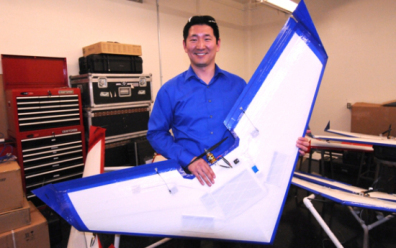 With the help of a DARPA research grant, Chung and his associates have completed a small fleet of about a dozen drones. Each is a essentially a commodity radio-controlled flying machine, called Unicorn, that has been retrofitted with an onboard computer and other gear in order to take their places in the larger group. He hopes that by this August, he and his team will be able to get the vehicles flying and be able to start experimenting with getting them working together, as well as facing off!
With the help of a DARPA research grant, Chung and his associates have completed a small fleet of about a dozen drones. Each is a essentially a commodity radio-controlled flying machine, called Unicorn, that has been retrofitted with an onboard computer and other gear in order to take their places in the larger group. He hopes that by this August, he and his team will be able to get the vehicles flying and be able to start experimenting with getting them working together, as well as facing off!
In other news, questions relating to drone dogfights and the issue of autonomous drones were raised once again at the White House. Back around Thanksgiving, the mounting concerns from the human rights community led Deputy Defense Secretary Ashton Carter to sign a series of instructions that were designed to ensure that human oversight would always be a factor where drone strikes and UAV’s were concerned.
 These concerns have since mounted with the recent announcement that John Brennan, the White House’s counter-terrorism adviser and the man known as the “Drone Godfather”, was nominated to become the next head of the CIA. For years now, he has been the man in charge of the US antiterrorism efforts in Central Asia, many of which have involved the controversial use of Predator and Reaper strikes.
These concerns have since mounted with the recent announcement that John Brennan, the White House’s counter-terrorism adviser and the man known as the “Drone Godfather”, was nominated to become the next head of the CIA. For years now, he has been the man in charge of the US antiterrorism efforts in Central Asia, many of which have involved the controversial use of Predator and Reaper strikes.
These concerns were voiced in a recent letter from Sen. Ron Wyden (D-Ore), a member of the Senate intelligence committee. In it, he asked Brennan pointedly when and under what conditions the president would be able to target American citizens using drones:
“How much evidence does the President need to determine that a particular American can be lawfully killed? Does the President have to provide individual Americans with the opportunity to surrender before killing them?”
Naturally, the questions were quite specific when it came to the authorization of lethal force and when such authorization would be given to target people within the US’s borders. But there were also many questions that highlighted concerns over how this same process of authorization has taken place in other countries, and how little oversight has taken place.
 In short, Wyden used the occasion to express “surprise and dismay” that the intelligence agencies haven’t provided the Senate intelligence committee with a complete list of countries in which they’ve killed people in the war on terrorism, a move which he says “reflects poorly on the Obama administration’s commitment to cooperation with congressional oversight.” And given the mounting criticism at home that using killer drones against unspecified targets in Afghanistan and Pakistan has earned, not to mention the blowback happening overseas, he is not alone in thinking this.
In short, Wyden used the occasion to express “surprise and dismay” that the intelligence agencies haven’t provided the Senate intelligence committee with a complete list of countries in which they’ve killed people in the war on terrorism, a move which he says “reflects poorly on the Obama administration’s commitment to cooperation with congressional oversight.” And given the mounting criticism at home that using killer drones against unspecified targets in Afghanistan and Pakistan has earned, not to mention the blowback happening overseas, he is not alone in thinking this.
Like it or not, it’s a new age where “umanning” the front lines is having an effect, albeit not the desired one. At one time, the predominant thinking in military and intelligence communities was that using automated aerial, land and sea vehicles, war could be fought cleanly, effectively, and without the loss of life – at least on OUR side. However, this thinking is coming under increasing scrutiny as it comes closer and closer to realization. And at the center of it all, the philosophical and existential questions are numerous and impossible to ignore.
For starters, war is and always will be a human endeavor. Just because you are not risking the lives of your own people doesn’t mean the fight is any more sanitary or bloodless. Second, even though none of your own citizens will be mourning the death of their loved ones doesn’t mean there won’t be mounting civilian opposition as conflicts go on. In a global community, people are able to witness and empathize with the plight of others. And finally, the increased use of machinery, be it autonomous or remote controlled, will inevitably lead to fears of what will happen if that same technology would ever be turned against its own people. No weapon is so safe and no government so trustworthy that people won’t fear the possibility of it being turned on them as well.
Source: news.cnet.com, wired.com


January 17, 2013
The Future is Here: The tDCS Headband!
 Oh what a time to be alive, when more and more science fiction concepts that once seemed hokey are now becoming a reality! Take the transcranial direct current stimulation for example, otherwise known as the tDCS. It’s essentially a high-tech headband, one which is used to trigger the release of the powerful opioids – the human body’s most powerful, euphoria-inducing painkillers that are very similar to opiates such as morphine.
Oh what a time to be alive, when more and more science fiction concepts that once seemed hokey are now becoming a reality! Take the transcranial direct current stimulation for example, otherwise known as the tDCS. It’s essentially a high-tech headband, one which is used to trigger the release of the powerful opioids – the human body’s most powerful, euphoria-inducing painkillers that are very similar to opiates such as morphine.
A team of international researchers headed up by the University of Michigan tested this noninvasive device and realized it could be both safe and effective. By applying a very small current to your scalp (2 milliamps), the headband alters the behavior of neurons in the brain, triggering the release of opioids that relieve pain, relax the body and create a general sense of well-being. This is big news for the medical industry and patients, since it means that artificial painkillers may not be necessary for much longer.
 To be fair, the tDCS is not entirely new. Back in March of 2012, DARPA announced that it was using this device to assist in the training of military sniper. Essentially, the device was created to alter brain chemistry since the application of current to the brain was shown to make neurons fire faster and improve their neurolasticity. In short, the device could improve reaction time and help users to learn things faster.
To be fair, the tDCS is not entirely new. Back in March of 2012, DARPA announced that it was using this device to assist in the training of military sniper. Essentially, the device was created to alter brain chemistry since the application of current to the brain was shown to make neurons fire faster and improve their neurolasticity. In short, the device could improve reaction time and help users to learn things faster.
However, Alexandre DaSilva and a team of researchers out of the University of Michigan found that the tDCS, when the electrodes are placed above the motor cortex, releases endogenous μ-opioid. In their study, the patient’s threshold for pain improved by 36% and the researchers seem confident that repeated uses of tDCS would also reduce clinical, chronic pain. By boosting the release of natural painkillers, less pharmaceutical opiates are required for managing pain, thus reducing the side effects and the risk of addiction.
 Further analysis and long-term trials are needed to confirm these initial results, and I’m thinking a study on the possible effects of tDCS abuse might be needed as well. Sure, patients can avoid getting hooked on Oxycontin, morphine, and codeine with this device, but couldn’t they also get hooked on their headband? Yes, I can see it now. “I don’t need to wear my TransCranBand! I can quite whenever I want!”
Further analysis and long-term trials are needed to confirm these initial results, and I’m thinking a study on the possible effects of tDCS abuse might be needed as well. Sure, patients can avoid getting hooked on Oxycontin, morphine, and codeine with this device, but couldn’t they also get hooked on their headband? Yes, I can see it now. “I don’t need to wear my TransCranBand! I can quite whenever I want!”
Source: Extremetech.com


Cybersleuths Uncover Worldwide Spy Virus
“I’m frightened because our enemies are no longer known to us. They do not exist on a map. They’re not nations, they’re individuals. And look around you. Who do you fear? Can you see a face, a uniform, a flag? No! Our world is not more transparent now, it’s more opaque! It’s in the shadows.”
This was one of the most memorable lines from the recent Bond movie Skyfall, as spoken by Dame Judi Dench in her role as M, director of MI6. It’s memorable because of how it managed to capture the essence of spy work in the post-Cold War digital age, and because it pretty much resounds with audiences who are increasingly fearful for their privacy.
In a story that I know I must comb for material for my next cyber novel, a team of cyber sleuths recently uncovered a cyberspy ring that has been spying on embassies, governments and research institutions around the world for the past five years. The virus, which has been dubbed “Red October”, is of uncertain origin, though the culprits are believed to be Russian (hence the name).
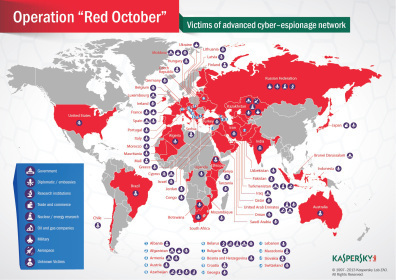 For the past five years, the virus has been harvesting documents and data from computers, smartphones and removable storage devices (such as USB sticks), largely from victims in Easter Europe and Central Asia. However, 69 countries were reported as being targeted in total, including the U.S., Australia, Ireland, Switzerland, Belgium, Brazil, Spain, South Africa, Japan and the United Arab Emirates. So far, these victims remain unidentified except to say that in most cases, they were government agencies and embassies, institutions involved in nuclear and energy research and companies in the oil and gas and aerospace industries.
For the past five years, the virus has been harvesting documents and data from computers, smartphones and removable storage devices (such as USB sticks), largely from victims in Easter Europe and Central Asia. However, 69 countries were reported as being targeted in total, including the U.S., Australia, Ireland, Switzerland, Belgium, Brazil, Spain, South Africa, Japan and the United Arab Emirates. So far, these victims remain unidentified except to say that in most cases, they were government agencies and embassies, institutions involved in nuclear and energy research and companies in the oil and gas and aerospace industries.
The virus was uncovered by the Kaspersky Lab, a Moscow-based antivirus firm that specializing in internet security. In a statement released on Monday the 14th: “The main purpose of the operation appears to be the gathering of classified information and geopolitical intelligence, although it seems that the information-gathering scope is quite wide.” The virus is still active, they say, but now that the operation is a matter of public record, there’s no telling if it will continue or not.
 What’s more interesting is the fact that the spy ring set up an extensive and complex infrastructure consisting of a chain of at least 60 command-and-control servers that appear to rivals the massive infrastructure used by the nation-state hackers that were behind the infamous Flame spay malware that was responsible for infiltrating computers in Iran and across the Middle East last year. However, Kaspersky went on to claim that this network was not associated with Flame, meaning that there is another hacker ring out there that is equally powerful and motivated, and has comparable infrastructure.
What’s more interesting is the fact that the spy ring set up an extensive and complex infrastructure consisting of a chain of at least 60 command-and-control servers that appear to rivals the massive infrastructure used by the nation-state hackers that were behind the infamous Flame spay malware that was responsible for infiltrating computers in Iran and across the Middle East last year. However, Kaspersky went on to claim that this network was not associated with Flame, meaning that there is another hacker ring out there that is equally powerful and motivated, and has comparable infrastructure.
All of this calls to mind the Anonymous and the whole debate about hacking and its ethics. Whereas the concept was born of a desire to make information free, deconstruct corporate and government control of media, and break down barriers between nation states, examples like this remind us that there are also insidious hackers, the ones who’s motivation is questionable and who’s actions are less than benign. Alongside “black hat” hackers, the people who spawn malware, spyware, and other viruses from their basements, hackers have it pretty bad on the PR front!
 But good or bad, the reality is that hacking and information wars are becoming an increasingly decentralized and democratic affair. For some, this is a good sign, an indication that we are moving towards a truly open and free society. For others, its a very bad sign, since we really have no idea how to contain threats that emerge from what are essentially non-entities.
But good or bad, the reality is that hacking and information wars are becoming an increasingly decentralized and democratic affair. For some, this is a good sign, an indication that we are moving towards a truly open and free society. For others, its a very bad sign, since we really have no idea how to contain threats that emerge from what are essentially non-entities.
I swear to God I didn’t pick this story to promote my new book, people! But for some reason, the news cycle seems to have decided to break a story that specifically addresses what I was trying to capture with that book and its planned sequels. So in addition to all the people these “Red October” individual may have screwed over, it seems that they’ve made me look like a shameless self-promoter! I don’t know what your agenda is, be it general mischief, anti-secrecy, freedom of information, or just plain anarchism, but did you ever once think of ME???
Source: Wired.com


January 15, 2013
The Future is Here: The Magic Forest LED Wall
 In an attempt to address the sterile feel of lobbies and waiting rooms in hospitals and clinics, a London design studio recently unveiled a very cool concept. Essentially, it’s an interactive wallpaper that turns clinical corridor walls into a magical forest which engages and distracts kids as they journey toward their procedure. Known as Nature Trail, the installation is a 50 meter (165 feet) long corridor that walls part of the Mittal Children’s Medical Centre at London’s Great Ormond Street Hospital.
In an attempt to address the sterile feel of lobbies and waiting rooms in hospitals and clinics, a London design studio recently unveiled a very cool concept. Essentially, it’s an interactive wallpaper that turns clinical corridor walls into a magical forest which engages and distracts kids as they journey toward their procedure. Known as Nature Trail, the installation is a 50 meter (165 feet) long corridor that walls part of the Mittal Children’s Medical Centre at London’s Great Ormond Street Hospital.
Jason Bruges, head of the Jason Bruges Studio and creator of the installation, claims that “the idea came from remembering walks in my childhood. I loved spotting and following things, those stolen glances and glimpses… I was trying to re-create this with the idea of digital lookout points along the corridor.” Relying on a series of 70 LED panels that house a total of 72,000 LEDs, the walls are triggered by motion sensors and reveal animated patterns in the shape of horses, deer, hedgehogs, birds, and frogs peeking through the foliage and trees.
 The studio modeled the critters in 3D before translating them to low resolution to give the creatures an aesthetic similar to an old-fashioned video game character. The creators then placed the LED panels at various heights so kids of all ages, and to take into account being bedridden or in a wheelchair, can access the animals at eye level. The hospital says its young patients have been so entranced by the nature canvas that it will grow to fill more walls by 2017.
The studio modeled the critters in 3D before translating them to low resolution to give the creatures an aesthetic similar to an old-fashioned video game character. The creators then placed the LED panels at various heights so kids of all ages, and to take into account being bedridden or in a wheelchair, can access the animals at eye level. The hospital says its young patients have been so entranced by the nature canvas that it will grow to fill more walls by 2017.
 As it stands, doctor’s offices, dental clinics and medical centers rely on aesthetics to combat what can only be described as the “clinical feel”. But this concept just may offer them a high-tech option that will put patients at ease through the illusion of a natural setting that is dazzling the eyes. Some might accuse men like Bruges of using technology to anesthetize, but for anyone who has had sick children, its likely to be seen as a godsend!
As it stands, doctor’s offices, dental clinics and medical centers rely on aesthetics to combat what can only be described as the “clinical feel”. But this concept just may offer them a high-tech option that will put patients at ease through the illusion of a natural setting that is dazzling the eyes. Some might accuse men like Bruges of using technology to anesthetize, but for anyone who has had sick children, its likely to be seen as a godsend!
Source: news.cnet.com


